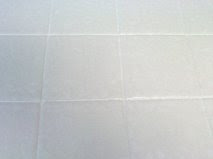CLEANING TILE FLOORS
When using bleach or other harsh chemicals, you may want to consider wearing protective gloves. Also, never mix cleaning chemicals. If you clean with bleach or other harsh chemicals, be sure the area is well-rinsed and has air dryed before cleaning that area with another cleaner.Tile floors are a handsome way to brighten the decor of your home, and provide a sturdy floor covering at the same time. Tiles are usually sealed with glaze, much like a potter's glaze, giving them their beautiful shine and making them virtually unbreakable. If protected, cared for, and cleaned properly, tiles can stay looking like new for many years.Simply clean them regularly, avoid dust and grit, and your tiles will look like new for years to come! After the tiles have been laid, see to it that they are sealed with the correct sealant. The manufacturer will recommend the correct sealant to use.
Many people want to polish their tiles or put treatment oils on them to make them extra shiny. Do this only if you have very good insurance or you don't ever intend to walk on the tiles. Oils and polishes make the floor dangerously slick, even for someone with rubber soled shoes. Oils also cause the tiles to attract dirt, thus making them extremely difficult to keep clean.
It is not difficult to clean tiled floors, but you should clean them regularly so that they don't lose their original luster and stains don't become permanent. If liquid spills on your tile floor, it should be wiped up immediately. The grout is porous and will absorb any liquids that are left to soak on it. So, to prevent your grout from become discolored and deeply stained, clean up spills quickly.
Before wet-cleaning your floor, you should sweep up or vacuum any loose dirt or food crumbs that are on the surface paying particular attention to corners. This will prevent scuffing the surface of your tile. Scratches in the tile's glaze will lead to dullness. Scratches also trap dirt which in turn causes future cleanings to become more difficult.











